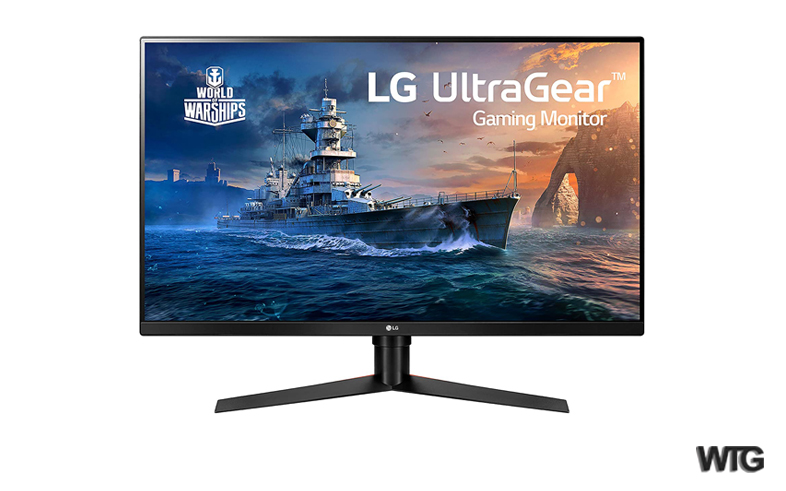
Best Gaming Monitor Under $400 – Ultimate Buying Guide
Many shoppers online like to save as much money as possible and have a specific budget in mind, and we honestly get it. The most common price buyers allocate for a new monitor is around 400 dollars. Thankfully, you can actually get a lot for you money when purchasing a monitor under 400 dollars nowadays.
- Best Gaming Monitor Under $400 – Ultimate Buying Guide
- What Can You Get With a Monitor Under $400?
- Best Gaming Monitor Under $400 – Quick List
- Best Gaming Monitor Under $400 – Reviews
- 1. LG 32GK650F-B – Best Overall
- 2. LG 27GL83A-B – Best LG 27 inch
- 3. Samsung Odyssey G5 – Best Samsung 32 inch
- 4. BenQ EX2780Q – Best with Speakers
- 5. ASUS VG289Q – Best 4K
- 6. Sceptre C275B-144R – Best Budget
- 7. ViewSonic XG2431 – Best ViewSonic 240Hz
- 8. Acer Predator XB253Q – Best 240Hz
- 9. Acer Nitro XZ342CK – Best Ultrawide
- 10. AOC CQ32G1 – Best Curved
- Related Articles
What Can You Get With a Monitor Under $400?
Screen Size
Monitors under 400 dollars typically have a 19 inch to 32 inch screen, with the majority being 24 inches. 24 inch monitors are currently the best selling size of all monitors, compared to every size at every price. 27 inch displays are also very popular, since they provide a larger screen to work with while still not taking up too much space. 32 inch monitors are quickly gaining in popularity, and literally could be the next standard at any time.
Resolution
Most monitors under 400 dollars have a 1920 x 1080, Full HD (FHD) screen resolution. FHD works perfectly with the 19 to 27 inch screen range, because the pixels are not as widely distributed, and produce a sharper more detailed image. If you’re looking for a 32 inch display, you should get a monitor with a QHD (2560 x 1440) or 4K (3840 x 2160) screen resolution.
Refresh Rate & Response Time
Refresh rates and response times are key factors for display imaging speed and for games. Most of the monitors under 400 dollars come with a 60Hz refresh rate and a 5ms response time. This will get the job done for most of your daily tasks and standard gaming. There are some monitors with higher specs, that can range from a 75Hz to 240Hz refresh rate.
Display Technology
The best monitors under 400 dollars mostly utilize IPS technology. IPS or In-Plane Switching displays, are more vibrant in color and have increased viewing angles compared to TN panels. TN panels appear to be dull when viewed from sides, while IPS displays do not fade.
Best Gaming Monitor Under $400 – Quick List
- LG 32GK650F-B – Best Overall
- LG 27GL83A-B – Best LG 27 inch
- Samsung Odyssey G5 – Best Samsung 32 inch
- BenQ EX2780Q – Best with Speakers
- ASUS VG289Q – Best 4K
- Sceptre C275B-144R – Best Budget
- ViewSonic XG2431 – Best ViewSonic 240Hz
- Acer Predator XB253Q – Best Acer 240Hz
- Acer Nitro XZ342CK – Best Ultrawide
- AOC CQ32G1 – Best Curved
Best Gaming Monitor Under $400 – Reviews
1. LG 32GK650F-B – Best Overall
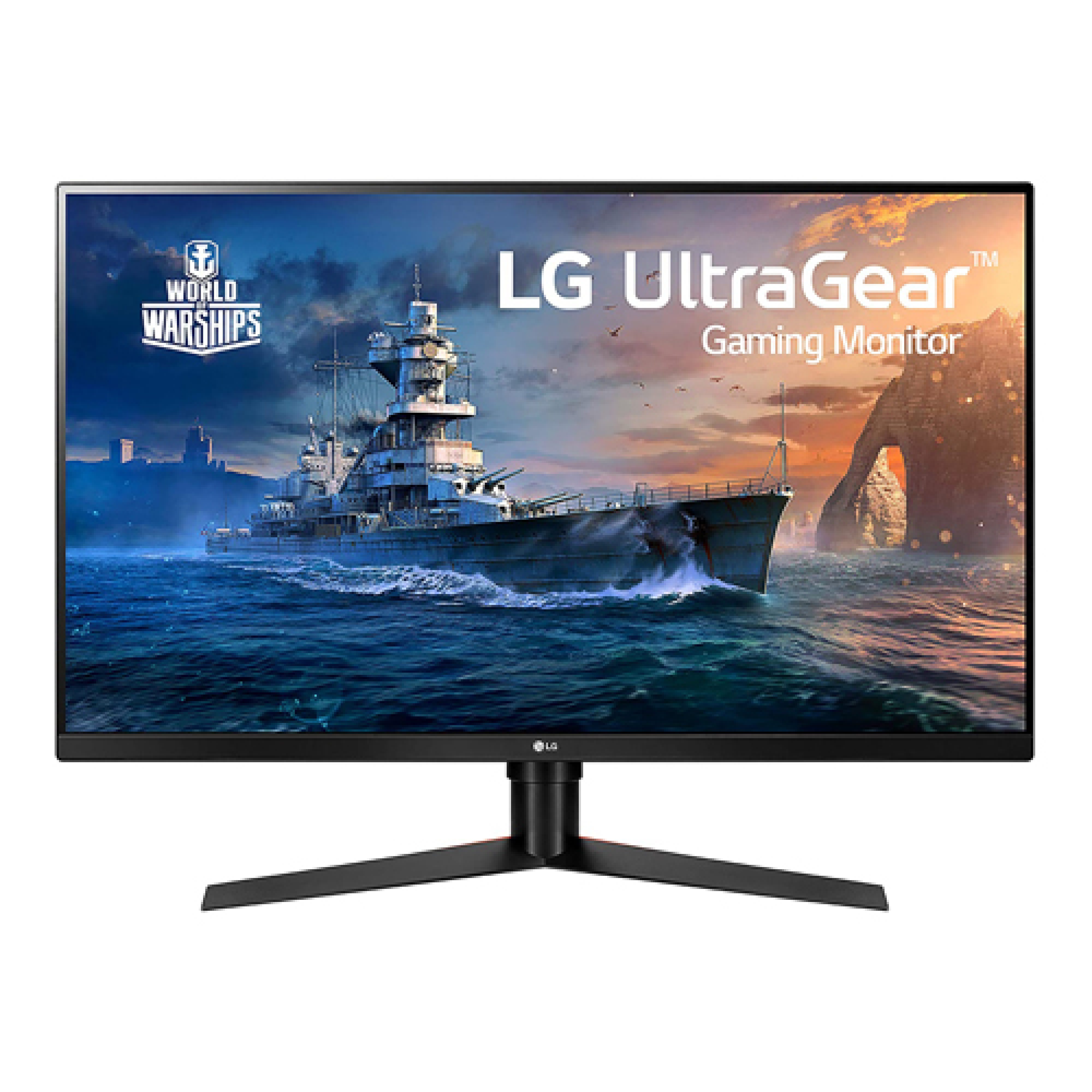
The LG 32GK650F-B exceeds expectations for a $400 budget. It may be categorized as a gaming monitor, but this LG monitor can literally do it all. From streaming your favorite movies and tv shows, browsing the web, reading and writing emails, creating spreadsheets, to gaming and more.
The LG 32GK650F-B packs a 1440p resolution with a 144 Hz refresh rate, so it falls into that golden zone for modern gaming. But on top of that, it uses VA technology which is popular with gamers and perhaps the best for this type of display.
It also has FreeSync support with low framerate compensation and it’s compatible with Nvidia GPUs. Some of the absolute cheapest monitors with these specs do not include adaptive sync, so having it here is not only welcome but a requirement for any modern gaming display.
Crucially, it’s also flat, which will please the curved display haters.
The LG’s QHD resolution of 2560×1440 will enable you to see every microscopic detail. Not only is your entertainment enhanced, but photo and video editing will be raised up a significant notch as well. You may never want to leave your pc.
What tops it all off is the massive 32 inch display. Your movies and games will be bigger and better, and you can also get more work done with multiple windows open simultaneously. It’s a game changer.
2. LG 27GL83A-B – Best LG 27 inch
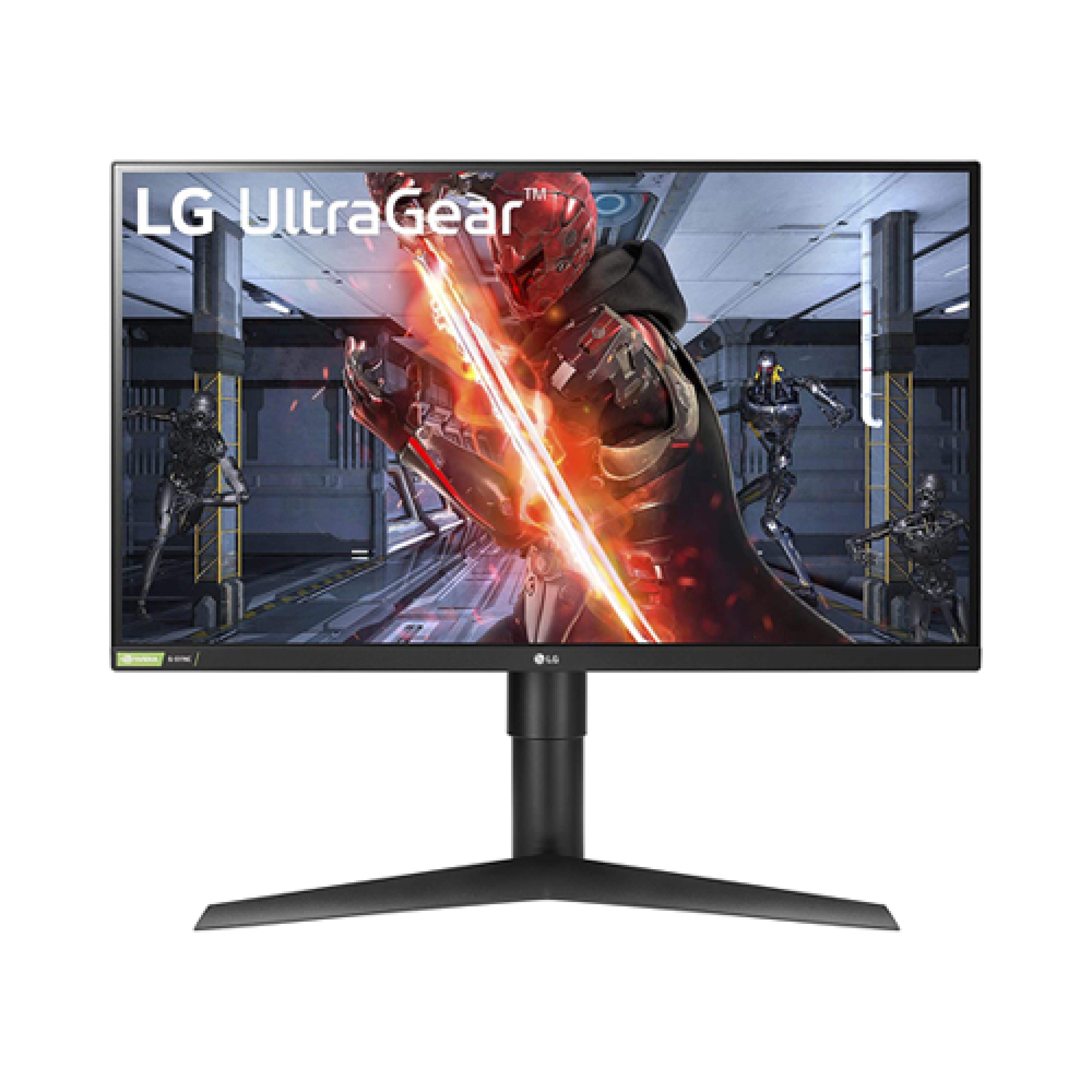
How does a 27 inch, 2K monitor with a 144Hz refresh rate, 1ms response time, and G Sync sound? It should be music to your ears, especially when it comes from a reputable brand such as LG. This literally is a monitor geared for gamers, and it has the tech to back it up.
You will be light years ahead of most of your competitors with the integrated technologies. The 1ms response time and 144Hz refresh rate will provide an essentially instantaneous response to your environment. Incredibly useful for first person shooters and other high speed action games.
The high color coverage of sRGB 99% ensures that you experience the game the way it was meant to be, with accurate vibrant colors. The integration of NVIDIA G Sync removes and reduces screen tearing and stuttering to ensure that you don’t miss a beat whilst in the heat of battle. The incredible contrasts give you an edge in areas with low light, where some enemies may literally not be able to see you, but you can see them.
If you are serious about gaming, you need a serious gaming monitor, and this is one of the best.
3. Samsung Odyssey G5 – Best Samsung 32 inch
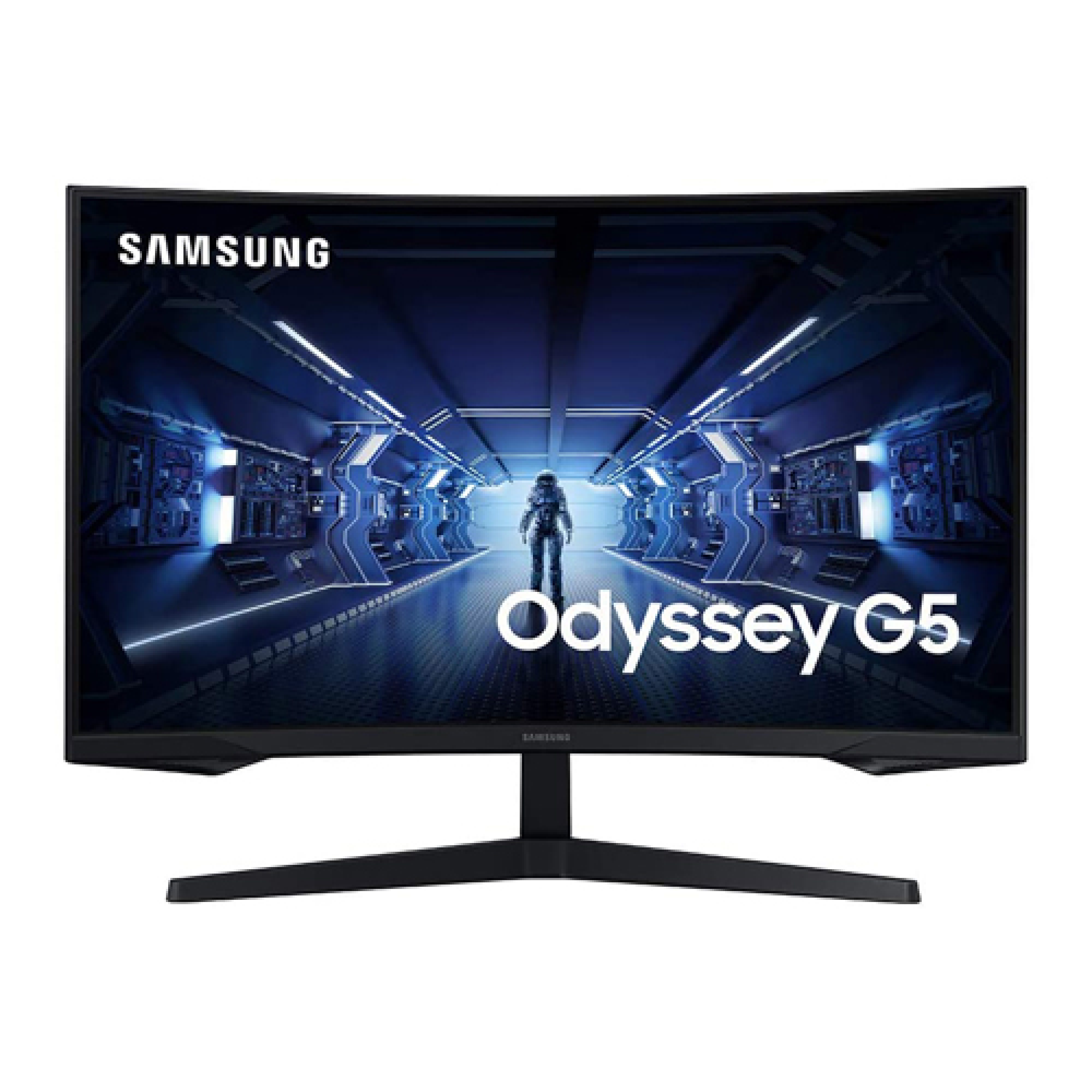
The Samsung Odyssey G5 features a 32 inch curved screen with a 2560×1440 Quad HD resolution, that truly pulls you into the action. The fast pace never stops thanks to the 144Hz refresh rate and 1ms response time. The AMD FreeSync Premium makes sure everything is effortlessly smooth throughout. The HDR10 brings true to life deep blacks and bright whites.
All said and done, the Samsung Odyssey G5 is a very affordable option for the serious gamer looking for an edge over the competition.
4. BenQ EX2780Q – Best with Speakers
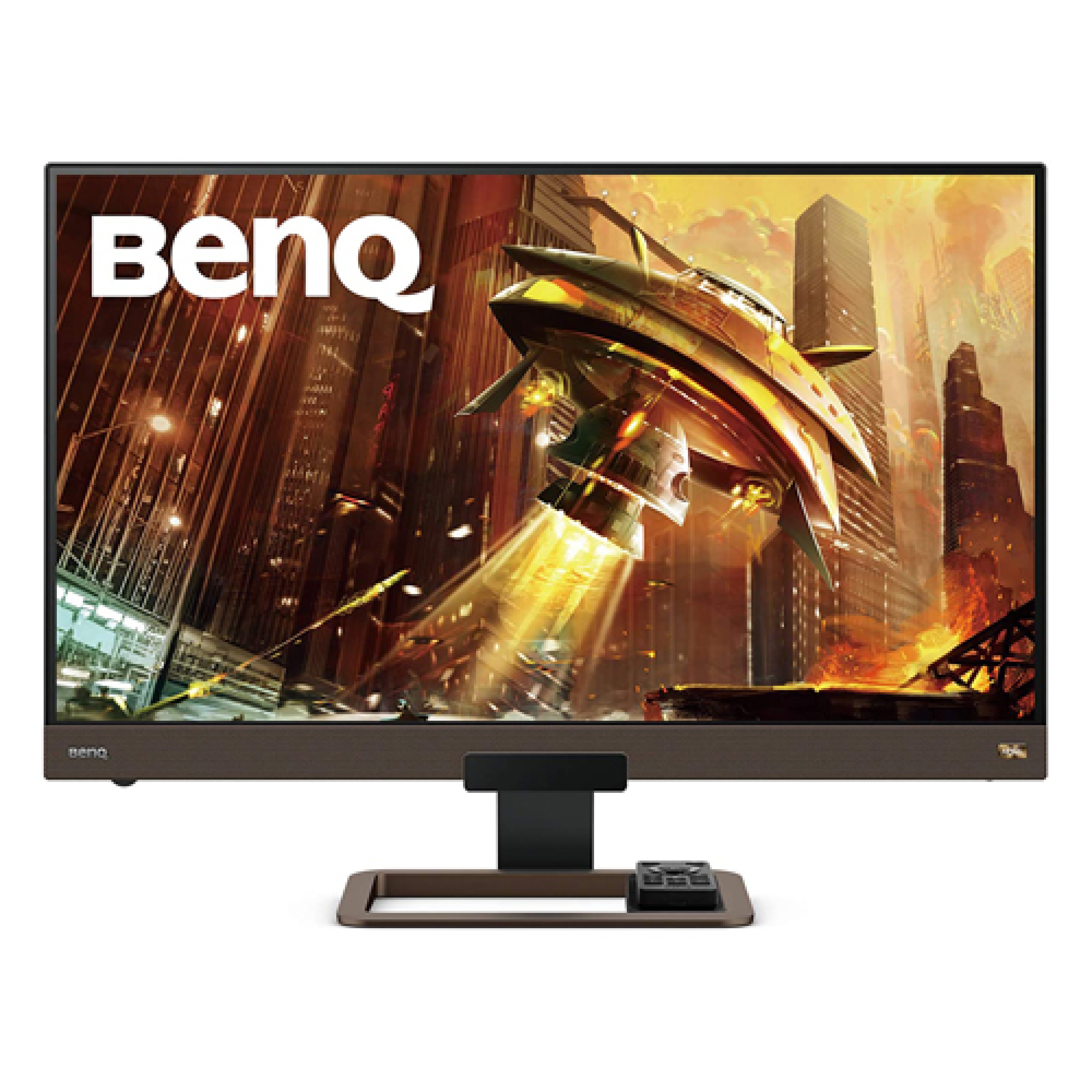
The BenQ EX2780Q is fairly similar to the LG 27GL83A-B, except the BenQ includes built in speakers. It’s the same size at 27 inches, has a 144Hz refresh rate, but the response time is not quite as good as the LG.
The BenQ has a unique feature of a HDRi sensor that optimizes your color, contrast, and image clarity. The sensor can automatically determine the ambient light and adjust the monitor’s screen for optimal performance.
The built in 2.1 channel speakers are pretty darn good for a monitor. It features 2x 2w speakers, a 5w subwoofer, and a DSP (Digital Signal Processor) which allows you to select the best audio mode for your game. It even comes with a remote to control it all.
5. ASUS VG289Q – Best 4K
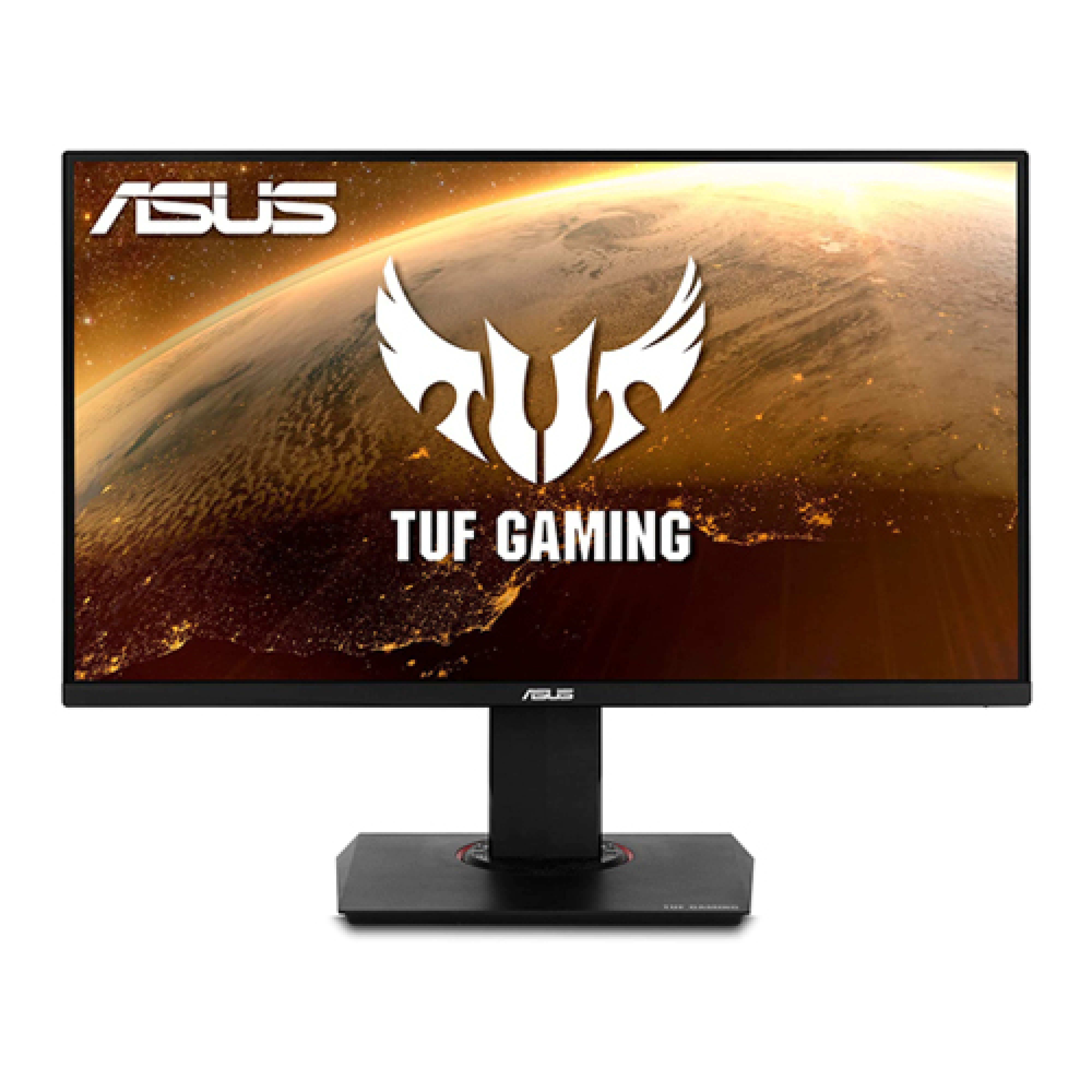
If you want a 4K gaming monitor with an IPS panel, the ASUS VG289Q is the best option in this price range.
Image quality
This 28″ monitor delivers vivid clarity and detail with its rich pixel density of 157 PPI.
Additionally, it supports 10-bit (8-bit + 2-bit FRC) color depth and 90% DCI-P3 wide color gamut for vibrant, consistent colors. For more accurate color output, you can simply use the provided sRGB emulation mode.
Its stunning colors and 4K UHD resolution make this monitor ideal for creating and consuming content, especially for jobs where color is essential, watching movies, gaming and other multimedia activities.
Characteristics
It supports AMD FreeSync over HDMI and DisplayPort with a VRR range of 40-60Hz, making it ideal for PC and console gaming. The VRR works fine with compatible NVIDIA cards, but your mileage may vary here as the monitor is not certified by NVIDIA as “G-SYNC Compatible”.
Other features include Shadow Boost (which changes the gamma curvature for better visibility of objects in shadow), a customizable reticle, pre-calibrated image presets, and on-screen timers.
HDR is also supported, but with a maximum brightness of 350-bit, it is not quality for VESA’s entry-level HDR support. Anyway, thanks to its wide color gamut, the colors will look a bit nicer on some HDR content, which is actually more than what some VESA HDR400 certified displays offer!
Design and connectivity
You can adjust the screen height up to 150mm, rotate the screen 90 °, tilt -5 ° / 20 °, rotate – / + 62 ° and mount it in VESA ( 100 × 100 mm).
Connectivity options include two HDMI 2.0 ports, a single DisplayPort 1.2 input, two integrated 2W speakers, and a headphone jack. The monitor also supports HDCP 2.2, allowing you to watch copy-protected content in native 4K UHD resolution on streaming services such as Netflix.
6. Sceptre C275B-144R – Best Budget
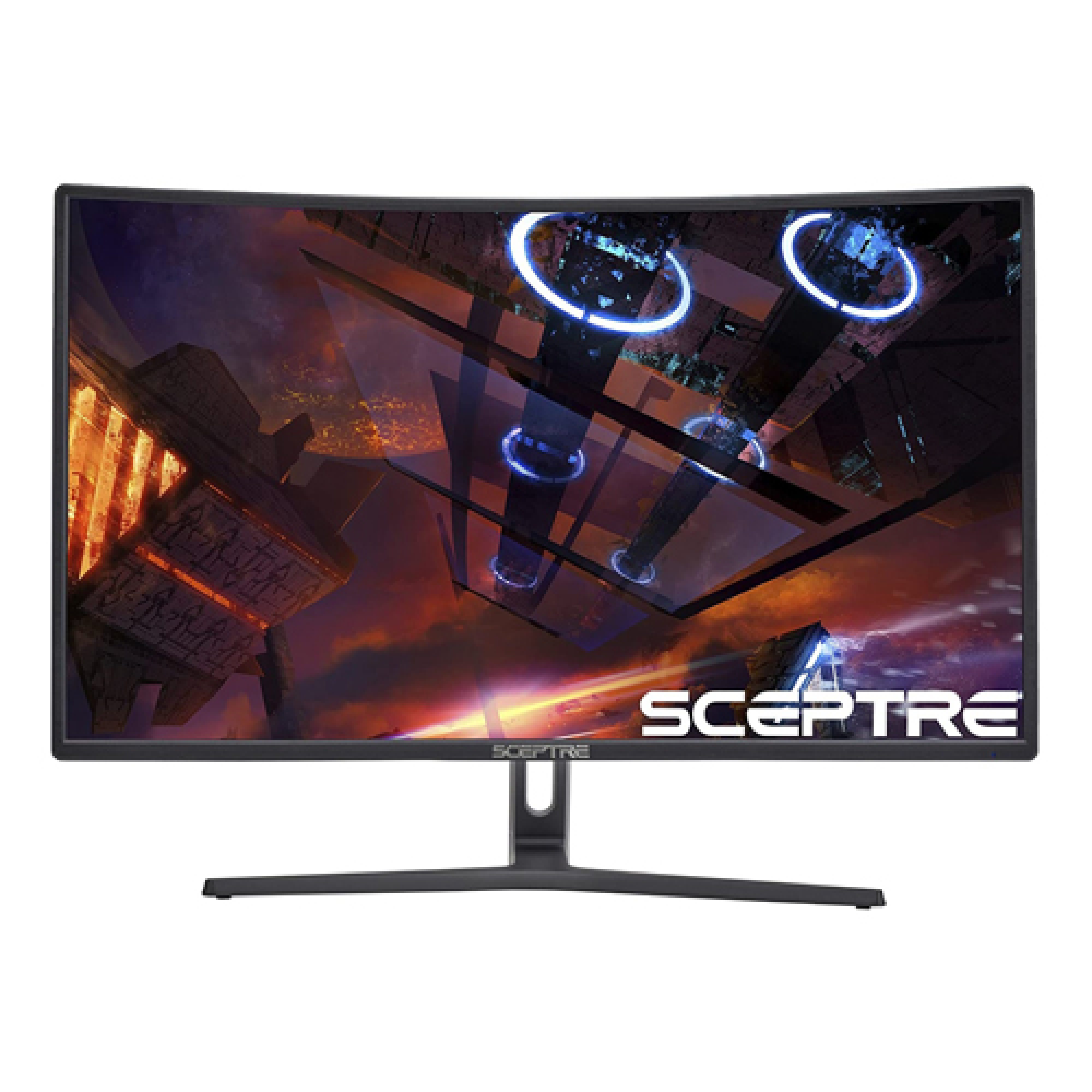
If you’re a serious gamer that is looking for a low priced, high quality gaming monitor, look no further.
The Sceptre C275B-144R is currently one of the highest rated & best selling gaming monitors on amazon right now. This is largely because it packs as many features as it can into a display that is now priced under $300.
The Sceptre C275B-144R has a substantial 27 inch curved screen that will definitely pull you into the action. It has a solid 144Hz refresh rate and AMD Freesync to ensure there is no tearing or stuttering gameplay. Just smooth, high paced graphics and motion.
This is another monitor that would be great in a multiple monitor setup. Due to it’s small bezels, VESA compatibility, and low price. It’s a winner.
7. ViewSonic XG2431 – Best ViewSonic 240Hz
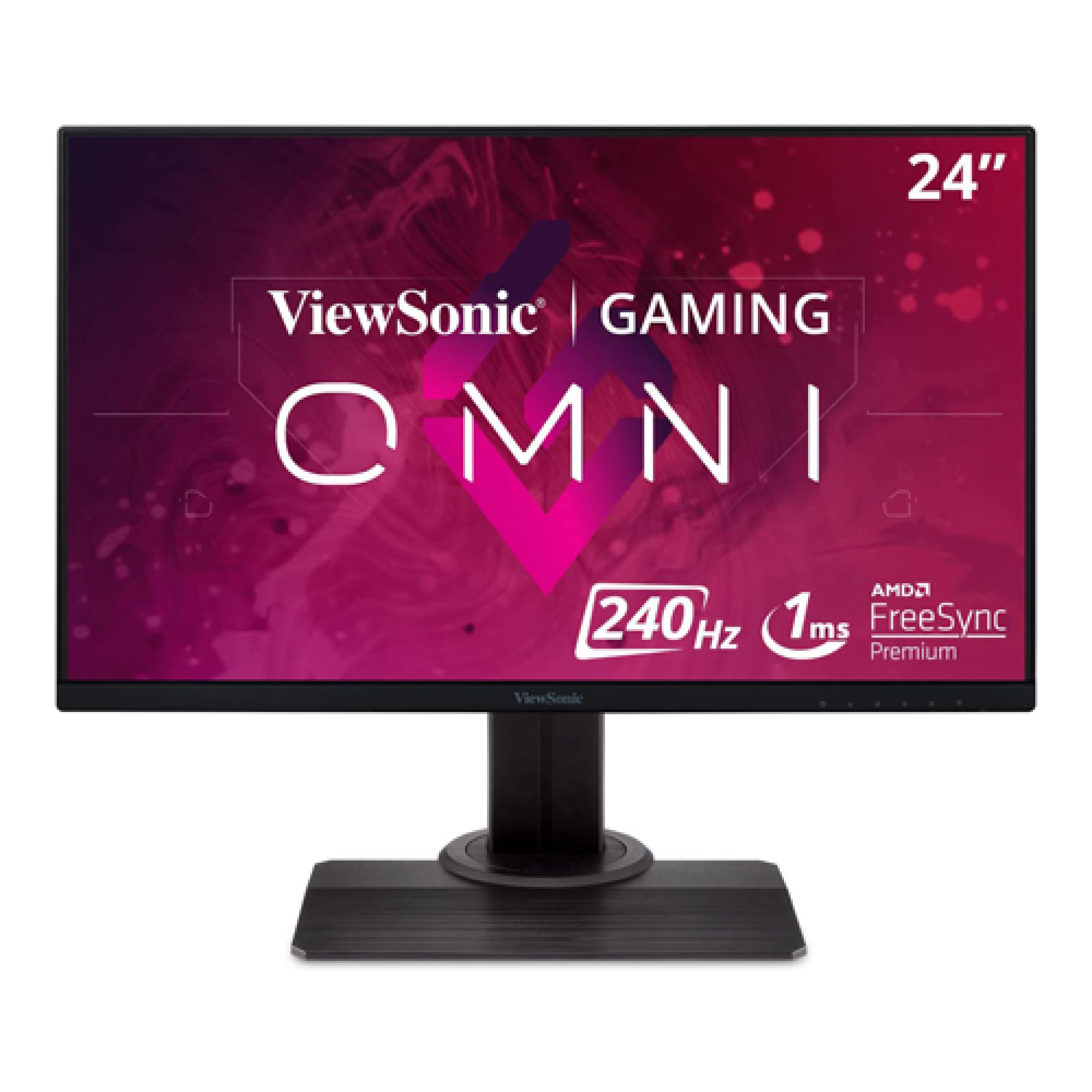
The ViewSonic XG2431 is easily one of the the best 240Hz gaming monitors.
It’s equipped with 240Hz, 1ms GtG response time, FreeSync and the impeccable PureXP+ backlight strobing implementation with Blur Busters 2.0 Approved certification.
Moreover, it offers vibrant colors and wide viewing angles!
Image Quality
Thanks to its IPS panel, the XG2431 delivers vivid and accurate colors that make the colors on TN panels look washed out in comparison.
IPS monitors also have 178° wide viewing angles both horizontally and vertically, so the image quality won’t degrade regardless of the angle you’re looking at the screen.
Further, its rapid 1ms GtG pixel response time speed eliminates any prominent trailing behind fast-moving objects.
Keep in mind that the jump from 144Hz to 240Hz isn’t as noticeable as going from 60Hz to 144Hz, but the difference is there, and it can be crucial for competitive gaming.
So, if you’re a hardcore FPS gamer, this is the monitor for you. However, if you’d rather have a smooth performance as well as a good image quality, there are better options included in this guide.
Features
The ViewSonic XG2431 supports AMD FreeSync with a 48-240Hz VRR range, and it offers stable G-SYNC Compatible performance.
Alternatively, you can use its backlight strobing technology called PureXP+ that offers exceptional motion clarity at a cost of picture brightness. Tuned by Blur Busters, this implementation allows for advanced customization and comes with well-optimized presets from 60Hz to 240Hz.
Other useful features include Black Stabilization (for better visibility in darker games), pre-calibrated picture modes (FPS, RTS, RGB, etc.) and a refresh rate tracker.
Design & Connectivity
The stand of the XG2431 monitor offers height adjustment up to 120mm, tilt by -5°/15°, +/- 90° swivel, 90° pivot and 100x100mm VESA mount compatibility.
Connectivity options include DisplayPort 1.4, two HDMI 2.0 inputs, a headphone jack, two 3W built-in speakers and a dual-USB 3.0 hub.
8. Acer Predator XB253Q – Best 240Hz
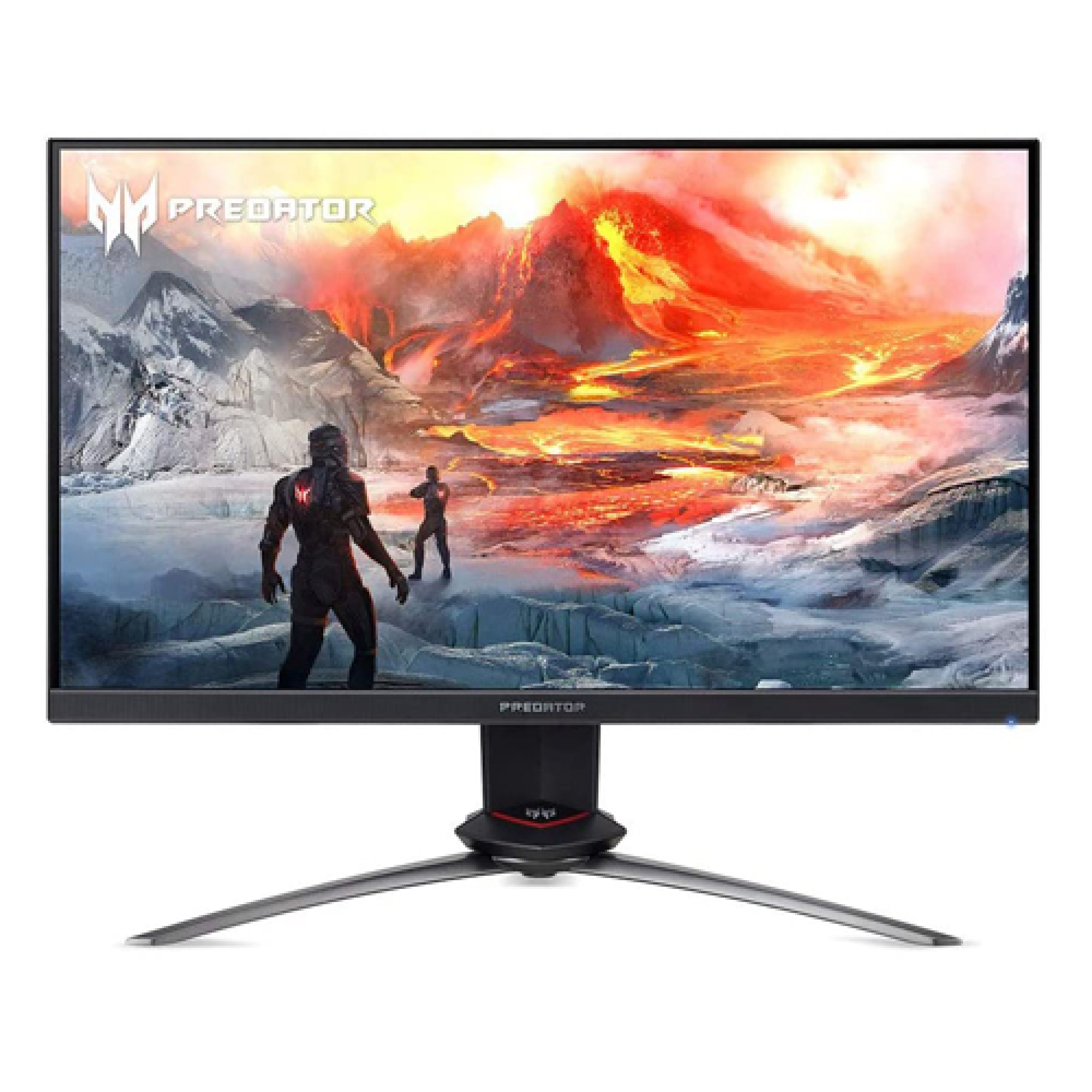
Picture Quality:
The 24.5 inches screen combined with Full-HD resolution can easily give a respectable pixel density of 90 PPI (pixels per inch). It is just right for the text and graphics to appear sharp and easily visible. It is a very distinctive gaming monitor because there are not many monitors in the market with the advantages of having an IPS panel and still able to achieve such right refresh rate and low response time.
Moreover, Acer Predators XB253Q’s IPS panel can offer wide viewing angles of 178°. It means no color shift when gaming or using the monitor at any other viewing angle. If this is not impressive enough, you will definitely love the vivid, accurate, and consistent color produced by its IPS panel which will provide an advantage when gaming. It’s 99% sRGB gamut and 8-bit color depth produces 16.7 million colors which are impressive.
Besides, the panel has a standard contrast ratio of 1000:1 and peak brightness of 400 nits. It is VESA HDR400 certified meaning it can perform screen level local dimming. it increases the dynamic contrast of the screen.
Performance:
The performance of Acer Predators XB253Q is impressive. It is that rare monitor that has the advantages of an IPS panel and still manages to produce a refresh rate of 240 Hz and an amazingly low response time of up to 0.5 ms. The high refresh rates offer a smooth gaming experience and low pixel response time ensures no ghosting or trailing when objects are moving fast while playing games.
Besides, it supports VRR(Variable refresh rate) with AMD FreeSync and Nvidia G-SYNC technology. It enables the capability of changing its refresh rate dynamically according to fps, which helps in eliminating screen tearing and stuttering.
What more you can ask. This is the reason it is the best monitor in terms of both performance and image quality. It is the perfect balance that is expected from an ideal gaming monitor.
Design:
The monitor stands on a tripod-like stand which gives a solid base to the monitor. The stand is quite flexible offering a Tilt of -5° to 25°, an overall height adjustment range of 4.7 inches, a swivel range of +/-20°, and a Pivot motion of +/-90°. The look of the monitor is aggressive and surely gives the vibe of a gaming monitor. The monitor is made of high-quality plastic painted all in black.
The Acer logo is on the left side at the back and also you will find a predator logo on the tip of the stand. It also has accent lines near the top of the stand which adds up to the overall look of the monitor. The bezels around the monitors are very slim which makes it more favorable for a multi-monitor setup. Also, reflection handling is on point all because of its low-haze anti-glare coating on the screen.
To sum up, it is the best gaming monitor you can get at this price point currently. The refresh rate of 240 Hz, Low response time of 0.5 ms, VESA HDR400 certification, and on-point color accuracy and consistency of the IPS panel does it all.
9. Acer Nitro XZ342CK – Best Ultrawide
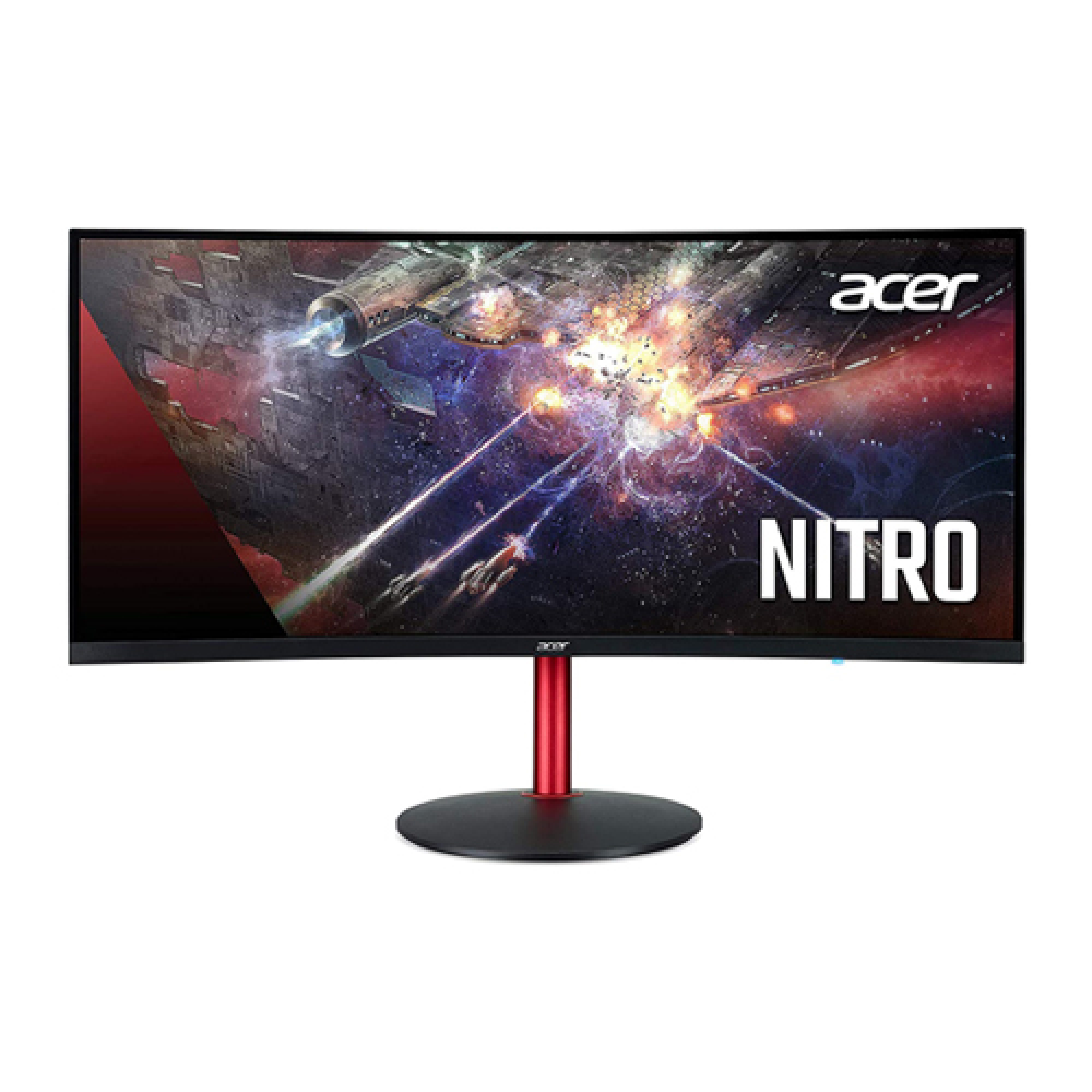
Acer Nitro XV340CK is a monitor that does not excel at all the criteria like gaming, editing, or watching movies in particular. Rather it is a monitor that combines the characteristics of all other monitors into one at a moderate level. This makes it the best monitors under 400 overall.
Picture Quality:
Acer XV340CK’s 3440×1440 resolution, 34-inch huge screen translates to a pixel density of about 110 PPI (pixels per inch). This makes everything sharper and immersive whether it is high res gaming, or QHD movie watching experience, or editing photos or videos.
It has an IPS panel which means colors are accurate, consistent, and vivid. Color coverage on this monitor is pretty decent, with 99% sRGB coverage it has enough variety of color. It has a true color depth of 8 bit producing 16.7 million colors. It supports HDR10 which will provide a more dynamic range, bright, and vibrant colors. The viewing angles are great on this monitor. No distortion visible even though it has a flat ultrawide display.
Moreover, the Acer XV340CK has a peak brightness of 250 nits. It is okay for normal conditions, unless in very bright rooms or under direct sunlight as glare would overcome the screen visibility. Also, you might see some backlight bleeding. It is normal with IPS panel and the bleed is not bothering.
Overall it is a good viewing experience on this ultrawide monitor.
Performance:
The Acer XV340CK delivers a very low pixel response time of 1 ms with VRB(Visual Response Boost ) enabled and a lower input lag of about 5 ms. That is extraordinary and improves overall gaming performance.
It packs FreeSync support, which improves gaming performance by eliminating screen tearing and stuttering. FreeSync changes the refresh rate of the monitor on the go to match the fps without compromising much of the input lag.
The AMD FreeSynch works in the range of 48-144Hz. If fps goes below 48, the frames rates are multiplied to give you smoother performance. This is cool. Although Acer XV340CK does not support G-Sync automatically, it can be enabled manually.
Design:
The monitor stands on a circular based stand which provides firm support to this huge ultrawide monitor with minimal wobble. The stands look standard and it is painted black. The stand only offers -5°/35° tilt adjustments. Thankfully, it is VESA compatible mount.
Moving on to the monitor itself, it looks nice overall. It has thinner look with super-thin bezels all around except for than big chin. Both monitor and stand are made of high-quality plastic material and doesn’t feel cheap.
Connectivity options on Acer XV340CK includes 2 x HDMI 2.0 ports, 2 x DisplayPort 1.4, a headphones jack, 3 x USB 3.0 (1 upstream and 2 down), and a dual 3W integrated speakers.
10. AOC CQ32G1 – Best Curved
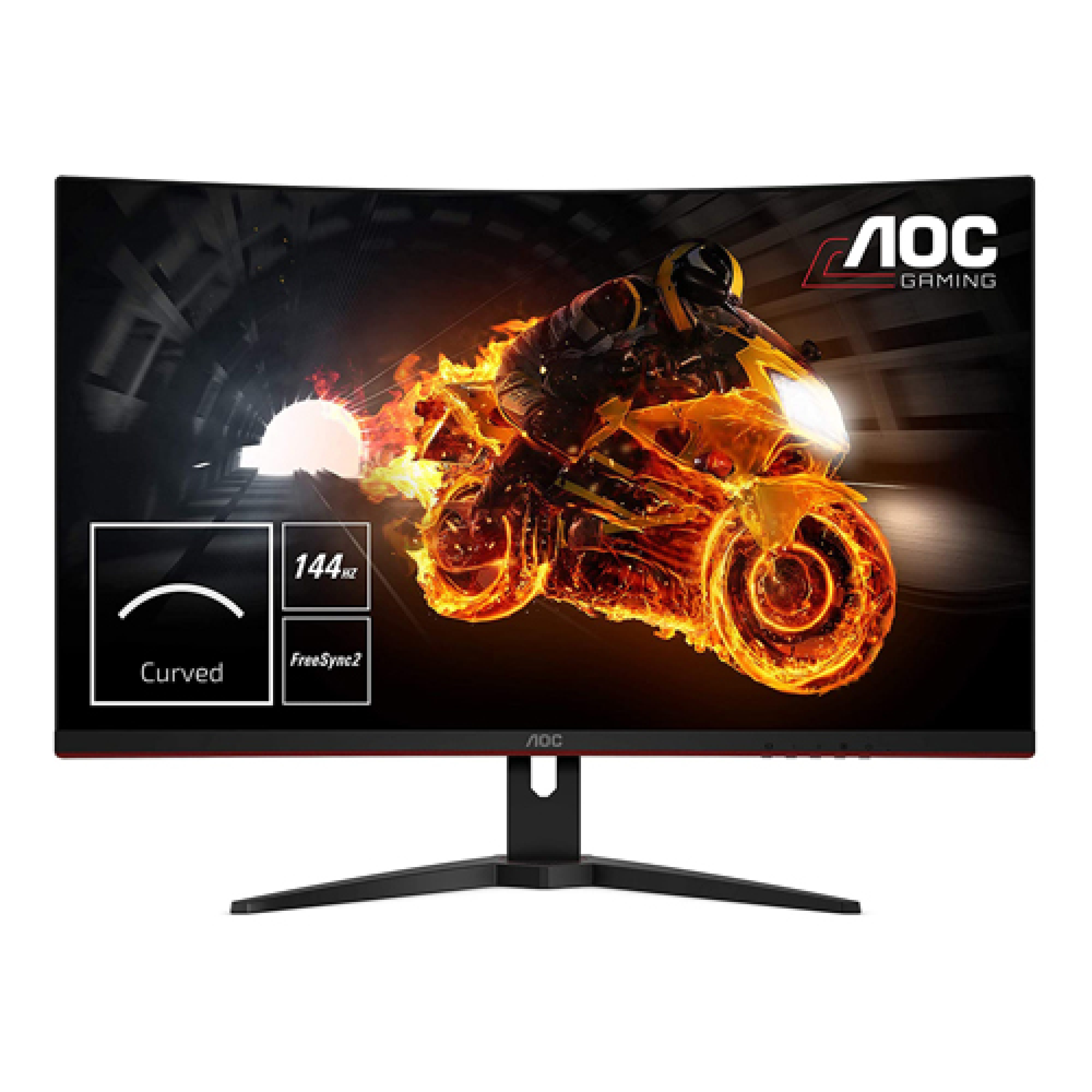
Want a large 32″ gaming monitor? The AOC CQ32G1 offers exceptional value for money. Note that there is no 32″ 1440p 144Hz model with TN or IPS models, so you’ll have to settle for a VA display if you want a 32″ display.
Image quality
Now, since the 2560 × 1440 resolution is displayed on a larger screen in this case, you won’t have as much space and detail as on a 27″ 1440p monitor.
However, you get a bigger screen which can make the gaming experience more immersive for some users. Keep in mind that a 32″ monitor is large enough and you will need to sit a little further away from the screen.
Other specs related to the display include a 3,000: 1 contrast ratio, 300-bit peak brightness, and a color gamut of around 125% sRGB.
Although the colors of the CQ32G1 are not as precise and consistent as those of the IPS panels, they are rich and vivid, much better than those of any TN model.
The monitor’s 3,000: 1 static contrast ratio results in deep blacks as well as a more vivid relationship between darker and lighter tones.
Alas, when pixels need to switch between colors, they can’t quite keep up with the refresh rate of the monitor. This results in visible drag from fast moving objects, especially noticeable in dark scenes where dark pixels are involved.
Some people can tolerate this phenomenon because in return you get excellent picture quality, but others, who play fast games in competition, will not be able to stand it.
So if you are a casual gamer this shouldn’t be a problem.
Features
The AOC CQ32G1 monitor features motion blur reduction technology which can be activated by setting the Overdrive parameter to “Boost”.
You can also adjust the frequency of the backlight strobes via the “MBR” parameter. This can go a long way in eliminating motion blur, but this feature cannot be enabled at the same time as FreeSync.
FreeSync is supported on both HDMI and DP with 48-144Hz dynamic refresh rate range with stable G-SYNC performance.
Plus, you’ll find pre-calibrated picture presets (FPS, RTS, Racing, and three customizable player profiles) as well as Shadow Control and Game Control for gamma / saturation adjustments.
Design and connectivity
The AOC CQ32G1 has a tilt mount only but it can be mounted to a third party mount via the VESA 100x100mm model. On the back of the monitor you will find HDMI 1.4, HDMI 2.0 and DisplayPort 1.2 inputs as well as an audio jack. The HDMI 1.4 port is limited to 75Hz at 1440p.
Alternatives
The AOC CQ32G1 is the best 32″ 1440p 144Hz gaming monitor you can get for under $400. If you want a similar monitor but with a flat screen instead, check out the LG 32GK650F.
If you are looking for a 27″ 1440p 144Hz gaming monitor with a VA panel, check out the detailed overview of the AOC CQ27G1 which is essentially a 27″ variant of the CQ32G1. It has an ergonomic design and costs only 250 dollars.
You can also get a 27″ 1440p 144Hz VA gaming monitor with a flat screen, the MSI MAG272QR .
Finally, if you want a good HDR gaming monitor, consider investing a little over $400 for the Samsung CHG70 with DisplayHDR 600, which means localized dimming, a wide color gamut, and a peak brightness of 600 bits for HDR content.
Related Articles
- Best 22 inch Monitor 2023
- Best 24 inch Monitor 2023
- Best 27 inch Monitor 2023
- Best 32 inch Monitor 2023
- Best 34 inch Monitor 2023
- Best 38 inch Monitor 2023
- Best 43 inch Monitor 2023
- Best 49 inch Monitor 2023
- Best Monitor Under $150
- Best Monitor Under $200
- Best Monitor Under $250
- Best Monitor Under $300
- Best Monitor Under $400
- Best Monitor Under $500
- Best IPS Monitor Under $200
- Best Vertical Monitor 2023
- Best Bezel Less Monitor 2023
- Best Ultrawide Monitor 2023
- Best Curved Monitor 2023
- Best Monitor with Speakers
- Best 2K Monitor 2023
- Best 120Hz Monitor 2023
- Best Monitor for Graphic Design 2023
- Best Budget Monitor for Graphic Design 2023
- Best Monitor for Programming 2023
- Best HP Monitor 2023
- Best LG Monitor 2023
- Best ViewSonic Monitor 2023
- Best BenQ Monitor 2023
- Best Sceptre Monitor 2023
- Best MSI Monitor 2023
- Best ASUS Gaming Monitor 2023
- Best Dual Monitor Stand
- Best Triple Monitor Stand
Best Monitor Under 400
A cathode-ray tube (CRT) computer monitor
Best Computer Monitors Under 400
Best Computer Monitors Under 400
The area, height and width of displays with identical diagonal measurements vary dependent on aspect ratio.
Best Computer Monitors Under 400
A fixed rack mount monitor is mounted directly to the rack with the LCD visible at all times. The height of the unit is measured in rack units (RU) and 8U or 9U are most common to fit 17-inch or 19-inch LCDs.
Best 24 inch Monitor Under 400
The front sides of the unit are provided with flanges to mount to the rack, providing appropriately spaced holes or slots for the rack mounting screws.
Best Monitor Under 400
A 19-inch diagonal LCD is the largest size that will fit within the rails of a 19-inch rack. Larger LCDs may be accommodated but are ‘mount-on-rack’ and extend forward of the rack.
Best 24 inch Monitor Under 400
There are smaller display units, typically used in broadcast environments, which fit multiple smaller LCDs side by side into one rack mount.
Best Computer Monitors Under 400
- Stowable
Best Monitors Under 400
A stowable rack mount monitor is 1U, 2U or 3U high and is mounted on rack slides allowing the display to be folded down and the unit slid into the rack for storage. The display is visible only when the display is pulled out of the rack and deployed.
Best Monitors Under 400
These units may include only a display or may be equipped with a keyboard creating a KVM (Keyboard Video Monitor). Most common are systems with a single LCD but there are systems providing two or three displays in a single rack mount system.
On two-dimensional display devices such as computer monitors the display size or view able image size is the actual amount of screen space that is available to display a picture, video or working space, without obstruction.
Best Monitor Under 400
A computer monitor is an output device that displays information in pictorial form. A monitor usually comprises the visual display, circuitry, casing, and power supply. The display device in modern monitors is typically a thin film.
Best Monitors Under 400
A computer monitor is an output device that displays information in pictorial form. A monitor usually comprises the visual display, circuitry, casing, and power supply.
Best Computer Monitors Under 400
The display device in modern monitors is typically a thin film transistor liquid crystal display (TFT-LCD) with LED backlighting having replaced cold-cathode fluorescent lamp (CCFL) backlighting. Older monitors used a cathode ray tube (CRT).
Best Computer Monitors Under 400
Monitors are connected to the computer via VGA, Digital Visual Interface (DVI), HDMI, DisplayPort, Thunderbolt, low-voltage differential signaling (LVDS) or other proprietary connectors and signals.
Best Monitor Under 400
Originally, computer monitors were used for data processing while television sets were used for entertainment.
Best Monitors Under 400
From the 1980s onwards, computers (and their monitors) have been used for both data processing and entertainment, while televisions have implemented some computer functionality. The common aspect ratio of televisions, and computer monitors, has changed from 4:3 to 16:10, to 16:9.
Best Computer Monitors Under 400
Modern computer monitors are easily interchangeable with conventional television sets and viceversa. However, as computer monitors do not necessarily include integrated speakers nor TV tuners (such as Digital television adapters), it may not be possible to use a computer monitor as a TV set without external components.[1]
Best Computer Monitors Under 400
Early electronic computers were fitted with a panel of light bulbs where the state of each particular bulb would indicate the on/off state of a particular register bit inside the computer.
Best Monitors Under 400
This allowed the engineers operating the computer to monitor the internal state of the machine, so this panel of lights came to be known as the ‘monitor’.
Best Monitor Under 400
As early monitors were only capable of displaying a very limited amount of information and were very transient, they were rarely considered for program output. Instead, a line printer was the primary output device, while the monitor was limited to keeping track of the program’s operation.[2]
Best Monitors Under 400
As technology developed engineers realized that the output of a CRT display was more flexible than a panel of light bulbs and eventually, by giving control of what was displayed in the program itself, the monitor itself became a powerful output device in its own right.[citation needed]
Best Computer Monitors Under 400
Computer monitors were formerly known as visual display units (VDU), but this term had mostly fallen out of use by the 1990s.
Best Monitor Under 400
Technologies[edit]
Best Computer Monitors Under 400
Further information: Comparison of CRT, LCD, Plasma, and OLED and History of display technology
Best 144hz Monitor Under 400
Multiple technologies have been used for computer monitors. Until the 21st century most used cathode ray tubes but they have largely been superseded by LCD monitors.
Best 144hz Monitor Under 400
Cathode ray tube[edit]
Main article: Cathode ray tube
Best 144hz Monitor Under 400
The first computer monitors used cathode ray tubes (CRTs). Prior to the advent of home computers in the late 1970s, it was common for a video display terminal (VDT) using a CRT to be physically integrated with a keyboard and other components of the system in a single large chassis.
Best 144hz Monitor Under 400
The display was monochrome and far less sharp and detailed than on a modern flat-panel monitor, necessitating the use of relatively large text and severely limiting the amount of information that could be displayed at one time.
Best Computer Monitors Under 400
High-resolution CRT displays were developed for the specialized military, industrial and scientific applications but they were far too costly for general use.
Best 144hz Monitor Under 400
Some of the earliest home computers (such as the TRS-80 and Commodore PET) were limited to monochrome CRT displays, but color display capability was already a standard feature of the pioneering Apple II, introduced in 1977, and the specialty of the more graphically sophisticated Atari 800, introduced in 1979.
Best 144hz Monitor Under 400
Either computer could be connected to the antenna terminals of an ordinary color TV set or used with a purpose-made CRT color monitor for optimum resolution and color quality.
Best 144hz Monitor Under 400
Lagging several years behind, in 1981 IBM introduced the Color Graphics Adapter, which could display four colors with a resolution of 320 x 200 pixels, or it could produce 640 x 200 pixels with two colors.
Best Computer Monitors Under 400
In 1984 IBM introduced the Enhanced Graphics Adapter which was capable of producing 16 colors and had a resolution of 640 x 350.[3]
Best 144hz Monitor Under 400
By the end of the 1980s color CRT monitors that could clearly display 1024 x 768 pixels were widely available and increasingly affordable. During the following decade, maximum display resolutions gradually increased and prices continued to fall.
Best 144hz Monitor Under 400
CRT technology remained dominant in the PC monitor market into the new millennium partly because it was cheaper to produce and offered to view angles close to 180 degrees.[4]
Best Gaming Monitors Under 400
CRTs still offer some image quality advantages[clarification needed] over LCDs but improvements to the latter have made them much less obvious.
Best Computer Monitors Under 400
The dynamic range of early LCD panels was very poor, and although text and other motionless graphics were sharper than on a CRT, an LCD characteristic known as pixel lag caused moving graphics to appear noticeably smeared and blurry.
Best Gaming Monitors Under 400
Liquid crystal display[edit]
Main articles: Liquid-crystal display and Thin-film-transistor liquid-crystal display
Best Gaming Monitors Under 400
There are multiple technologies that have been used to implement liquid crystal displays (LCD). Throughout the 1990s, the primary use of LCD technology as computer monitors was in laptops where the lower power consumption, lighter weight, and smaller physical size of LCDs justified the higher price versus a CRT.
Best Gaming Monitors Under 400
Commonly, the same laptop would be offered with an assortment of display options at increasing price points: (active or passive) monochrome, passive color, or active matrix color (TFT). As volume and manufacturing capability have improved, the monochrome and passive color technologies were dropped from most product lines.
Best Gaming Monitors Under 400
TFT-LCD is a variant of LCD which is now the dominant technology used for computer monitors.[5]
Best Gaming Monitors Under 400
The first standalone LCDs appeared in the mid-1990s selling for high prices. As prices declined over a period of years they became more popular, and by 1997 were competing with CRT monitors.
Best Gaming Monitors Under 400
Among the first desktop LCD computer monitors was the Eizo L66 in the mid-1990s, the Apple Studio Display in 1998, and the Apple Cinema Display in 1999. In 2003, TFT-LCDs outsold CRTs for the first time, becoming the primary technology used for computer monitors.[4]
Best Gaming Monitors Under 400
The main advantages of LCDs over CRT displays are that LCDs consume less power, take up much less space, and are considerably lighter. The now common active matrix TFT-LCD technology also has less flickering than CRTs, which reduces eye strain.[6]
Best Gaming Monitors Under 400
On the other hand, CRT monitors have superior contrast, have a superior response time, are able to use multiple screen resolutions natively, and there is no discernible flicker if the refresh rate[7] is set to a sufficiently high value. LCD monitors have now very high temporal accuracy and can be used for vision research.[8]
Best Gaming Monitors Under 400
High dynamic range (HDR)[7] has been implemented into high-end LCD monitors to improve color accuracy. Since around the late 2000s, widescreen LCD monitors have become popular.
Best Computer Monitors Under 400
In part due to television series, motion pictures and video games transitioning to high-definition (HD), which makes standard-width monitors unable to display them correctly as they either stretch or crop HD content.
Best Gaming Monitors Under 400
These types of monitors may also display it in the proper width, however they usually fill the extra space at the top and bottom of the image with black bars.
Best Computer Monitors Under 400
Other advantages of widescreen monitors over standard-width monitors is that they make work more productive by displaying more of a user’s documents and images, and allow displaying toolbars with documents.
Best Gaming Monitors Under 400
They also have a larger viewing area, with a typical widescreen monitor having a 16:9 aspect ratio, compared to the 4:3 aspect ratio of a typical standard-width monitor.
Best Gaming Monitors Under 400
Main article: Organic light-emitting diode
Best Gaming Monitors Under 400
Organic light-emitting diode (OLED) monitors provide higher contrast and better viewing angles than LCDs but they require more power when displaying documents with white or bright backgrounds and have a severe problem known as burn-in. They are less common than LCD monitors and are often more expensive.
Best Gaming Monitors Under 400
Measurements of performance[edit]
Best Gaming Monitors Under 400
The performance of a monitor is measured by the following parameters:
- Luminance is measured in candelas per square meter (cd/m2 also called a Nit).
- Color depth is measured in bits per primary color or bits for all colors.
- Gamut is measured as coordinates in the CIE 1931 color space. The names sRGB or Adobe RGB are shorthand notations.
- Aspect ratio is the ratio of the horizontal length to the vertical length. Monitors usually have the aspect ratio 4:3, 5:4, 16:10 or 16:9.
- Viewable image size is usually measured diagonally, but the actual widths and heights are more informative since they are not affected by the aspect ratio in the same way. For CRTs, the viewable size is typically 1 in (25 mm) smaller than the tube itself.
- Display resolution is the number of distinct pixels in each dimension that can be displayed. For a given display size, maximum resolution is limited by dot pitch.
- Dot pitch is the distance between sub-pixels of the same color in millimeters. In general, the smaller the dot pitch, the sharper the picture will appear.
- Refresh rate is the number of times in a second that a display is illuminated. Maximum refresh rate is limited by response time.
- Response time is the time a pixel in a monitor takes to go from active (white) to inactive (black) and back to active (white) again, measured in milliseconds. Lower numbers mean faster transitions and therefore fewer visible image artifacts.
- Contrast ratio is the ratio of the luminosity of the brightest color (white) to that of the darkest color (black) that the monitor is capable of producing.
- Power consumption is measured in watts.
- Delta-E: Color accuracy is measured in delta-E; the lower the delta-E, the more accurate the color representation. A delta-E of below 1 is imperceptible to the human eye. Delta-Es of 2 to 4 are considered good and require a sensitive eye to spot the difference.
- Viewing angle is the maximum angle at which images on the monitor can be viewed, without excessive degradation to the image. It is measured in degrees horizontally and vertically.
Best Gaming Monitors Under 400
Main article: Display size
Best Gaming Monitors Under 400
The area, height and width of displays with identical diagonal measurements vary dependent on aspect ratio.
Best Gaming Monitors Under 400
On two-dimensional display devices such as computer monitors the display size or view able image size is the actual amount of screen space that is available to display a picture, video or working space, without obstruction from the case or other aspects of the unit’s design.
Best 24 inch Monitor Under 400
The main measurements for display devices are: width, height, total area and the diagonal.
Best Monitors Under 400
The size of a display is usually by monitor manufacturers given by the diagonal, i.e. the distance between two opposite screen corners. This method of measurement is inherited from the method used for the first generation of CRT television, when picture tubes with circular faces were in common use.
Best Monitors Under 400
Being circular, it was the external diameter of the glass envelope that described their size. Since these circular tubes were used to display rectangular images, the diagonal measurement of the rectangular image was smaller than the diameter of the tube’s face (due to the thickness of the glass).
Best Monitors Under 400
This method continued even when cathode ray tubes were manufactured as rounded rectangles; it had the advantage of being a single number specifying the size, and was not confusing when the aspect ratio was universally 4:3.
Best Monitors Under 400
With the introduction of flat panel technology, the diagonal measurement became the actual diagonal of the visible display. This meant that an eighteen-inch LCD had a larger visible area than an eighteen-inch cathode ray tube.
Best Monitor Under 400$
The estimation of the monitor size by the distance between opposite corners does not take into account the display aspect ratio, so that for example a 16:9 21-inch (53 cm) widescreen display has less area, than a 21-inch (53 cm) 4:3 screen.
Best 24 inch Monitor Under 400
The 4:3 screen has dimensions of 16.8 in × 12.6 in (43 cm × 32 cm) and area 211 sq in (1,360 cm2), while the widescreen is 18.3 in × 10.3 in (46 cm × 26 cm), 188 sq in (1,210 cm2).
Best Monitor Under 400$
Main article: Display aspect ratio
Until about 2003, most computer monitors had a 4:3 aspect ratio and some had 5:4. Between 2003 and 2006, monitors with 16:9 and mostly 16:10 (8:5) aspect ratios became commonly available, first in laptops and later also in standalone monitors.
Best Monitor Under 400$
Reasons for this transition was productive uses for such monitors, i.e. besides widescreen computer game play and movie viewing, are the word processor display of two standard letter pages side by side, as well as CAD displays of large-size drawings and CAD application menus at the same time.[9][10]
Best Monitors Under 400
In 2008 16:10 became the most common sold aspect ratio for LCD monitors and the same year 16:10 was the mainstream standard for laptops and notebook computers.[11]
Best Monitor Under 400$
In 2010 the computer industry started to move over from 16:10 to 16:9 because 16:9 was chosen to be the standard high-definition television display size, and because they were cheaper to manufacture.
Best Monitor Under 400$
In 2011 non-widescreen displays with 4:3 aspect ratios were only being manufactured in small quantities.
Best 24 inch Monitor Under 400
According to Samsung this was because the “Demand for the old ‘Square monitors’ has decreased rapidly over the last couple of years,” and “I predict that by the end of 2011, production on all 4:3 or similar panels will be halted due to a lack of demand.”[12]
Best Monitor Under 400$
Main article: Display resolution
The resolution for computer monitors has increased over time. From 320×200 during the early 1980s, to 1024×768 during the late 1990s. Since 2009, the most commonly sold resolution for computer monitors is 1920×1080.[13]
Best Monitor Under 400$
Before 2013 top-end consumer LCD monitors were limited to 2560×1600 at 30 in (76 cm), excluding Apple products and CRT monitors. Apple introduced 2880×1800 with Retina MacBook Pro at 15.4 in (39 cm) on January 12, 2012, and introduced a 5120×2880 Retina iMac at 27 in (69 cm) on December 16, 2014. By 2015 most major display manufacturers had released 3840×2160 resolution displays.
Best Monitor Under 400$
Main article: Gamut
Best Monitors Under 400
Every RGB monitor has its own color gamut, bounded in chromaticity by a color triangle. Some of these triangles are smaller than the sRGB triangle, some are larger. Colors are typically encoded by 8 bits per primary color.
Best Computer Monitors Under 400
The RGB value [255, 0, 0] represents red, but slightly different colors in different color spaces such as AdobeRGB and sRGB. Displaying sRGB-encoded data on wide-gamut devices can give an unrealistic result.[14]
Best Monitor Under 400$
The gamut is a property of the monitor; the image color space can be forwarded as Exif metadata in the picture. As long as the monitor gamut is wider than the color space gamut, correct display is possible, if the monitor is calibrated.
Best Monitor Under 400$
A picture that uses colors that are outside the sRGB color space will display on an sRGB color space monitor with limitations.[15] Still today, many monitors that can display the sRGB color space are not factory adjusted to display it correctly.
Best Computer Monitors Under 400
Color management is needed both in electronic publishing (via the Internet for display in browsers) and in desktop publishing targeted to print.
Best Monitors Under 400
Additional features[edit]
Best Monitor Under 400$
Most modern monitors will switch to a power-saving mode if no video-input signal is received. This allows modern operating systems to turn off a monitor after a specified period of inactivity.
Best 24 inch Monitor Under 400
This also extends the monitor’s service life. Some monitors will also switch themselves off after a time period on standby.
Best Monitor Under 400$
Most modern laptops provide a method of screen dimming after periods of inactivity or when the battery is in use. This extends battery life and reduces wear.
Best Monitor Under 400$
Many monitors have other accessories (or connections for them) integrated. This places standard ports within easy reach and eliminates the need for another separate hub, camera, microphone, or set of speakers.
Best Monitor Under 400$
These monitors have advanced microprocessors which contain codec information, Windows Interface drivers and other small software which help in proper functioning of these functions.
Best Monitor Under 400$
Main article: Glossy display
Best Monitors Under 400
Some displays, especially newer LCD monitors, replace the traditional anti-glare matte finish with a glossy one. This increases color saturation and sharpness but reflections from lights and windows are very visible. Anti-reflective coatings are sometimes applied to help reduce reflections, although this only mitigates the effect.
Best Monitor Under 400$
In about 2009, NEC/Alienware together with Ostendo Technologies (based in Carlsbad, CA) were offering a curved (concave) 43-inch (110 cm) monitor that allows better viewing angles near the edges, covering 75% of peripheral vision in the horizontal direction.
Best Monitor Under 400$
This monitor had 2880×900 resolution, LED backlight and was marketed as suitable both for gaming and office work, while for $6499 it was rather expensive.[16] While this particular monitor is no longer in production, most PC manufacturers now offer some sort of curved desktop display.
Best Monitor Under 400$
Narrow viewing angle screens are used in some security conscious applications.
3D[edit]
Best Monitor Under 400$
See also: Active shutter 3D system, Polarized 3D system, and Autostereoscopy
Best Monitors Under 400
Newer monitors are able to display a different image for each eye, often with the help of special glasses, giving the perception of depth. An autostereoscopic screen can generate 3D images without headgear.
Best Monitor Under 400$
Main article: Touchscreen
Best 24 inch Monitor Under 400
These monitors use touching of the screen as an input method. Items can be selected or moved with a finger, and finger gestures may be used to convey commands. The screen will need frequent cleaning due to image degradation from fingerprints.
Best Monitor Under 400$
Main article: Graphics tablet/screen hybrid
Best Monitor Under 400$
A combination of a monitor with a graphics tablet. Such devices are typically unresponsive to touch without the use of one or more special tools’ pressure.
Best 24 inch Monitor Under 400
Newer models however are now able to detect touch from any pressure and often have the ability to detect tilt and rotation as well.
Touch and tablet screens are used on LCDs as a substitute for the light pen, which can only work on CRTs.
Best Monitor Under 400$
Main article: 21:9 aspect ratio
Monitors that feature an aspect ratio of 21:9 or 32:9 as opposed to the more common 16:9. 32:9 monitors are marketed as super ultrawide monitors.
Best Monitor Under 400$
Computer monitors are provided with a variety of methods for mounting them depending on the application and environment.
Best Monitor Under 400$
A desktop monitor is typically provided with a stand from the manufacturer which lifts the monitor up to a more ergonomic viewing height. The stand may be attached to the monitor using a proprietary method or may use, or be adaptable to, a Video Electronics Standards Association, VESA, standard mount.
Best Monitor Under 400$
Using a VESA standard mount allows the monitor to be used with an after-market stand once the original stand is removed. Stands may be fixed or offer a variety of features such as height adjustment, horizontal swivel, and landscape or portrait screen orientation.
Best Monitor Under 400$
The Flat Display Mounting Interface (FDMI), also known as VESA Mounting Interface Standard (MIS) or colloquially as a VESA mount, is a family of standards defined by the Video Electronics Standards Association for mounting flat panel monitors, TVs, and other displays to stands or wall mounts.[17] It is implemented on most modern flat-panel monitors and TVs.
Best Monitor Under 400$
For Computer Monitors, the VESA Mount typically consists of four threaded holes on the rear of the display that will mate with an adapter bracket.
Best Monitor Under 400$
Rack mount computer monitors are available in two styles and are intended to be mounted into a 19-inch rack:
Best Monitor Under 400$
A fixed 19-inch (48 cm), 4:3 rack mount LCD monitor
Best Monitor Under 400$
A fixed rack mount monitor is mounted directly to the rack with the LCD visible at all times. The height of the unit is measured in rack units (RU) and 8U or 9U are most common to fit 17-inch or 19-inch LCDs.
Best 24 inch Monitor Under 400
The front sides of the unit are provided with flanges to mount to the rack, providing appropriately spaced holes or slots for the rack mounting screws.
Best Monitor Under 400$
A 19-inch diagonal LCD is the largest size that will fit within the rails of a 19-inch rack.
Best 24 inch Monitor Under 400
Larger LCDs may be accommodated but are ‘mount-on-rack’ and extend forward of the rack.
Best 24 inch Monitor Under 400
There are smaller display units, typically used in broadcast environments, which fit multiple smaller LCDs side by side into one rack mount.
Best Monitor Under 400$
A 1U stowable clamshell 19-inch (48 cm), 4:3 rack mount LCD monitor with keyboard
Best 24 inch Monitor Under 400
A stowable rack mount monitor is 1U, 2U or 3U high and is mounted on rack slides allowing the display to be folded down and the unit slid into the rack for storage.
Best 24 inch Monitor Under 400
The display is visible only when the display is pulled out of the rack and deployed.
Best Monitor Under 400$
These units may include only a display or may be equipped with a keyboard creating a KVM (Keyboard Video Monitor).
Best 24 inch Monitor Under 400
Most common are systems with a single LCD but there are systems providing two or three displays in a single rack mount system.
Best 24 inch Monitor Under 400
A panel mount 19-inch (48 cm), 4:3 rack mount LCD monitor
Best Monitor Under 400$
A panel mount computer monitor is intended for mounting into a flat surface with the front of the display unit protruding just slightly. They may also be mounted to the rear of the panel.
Best 24 inch Monitor Under 400
A flange is provided around the LCD, sides, top and bottom, to allow mounting. This contrasts with a rack mount display where the flanges are only on the sides.
Best Monitor Under 400$
The flanges will be provided with holes for thru-bolts or may have studs welded to the rear surface to secure the unit in the hole in the panel.
Best 24 inch Monitor Under 400
Often a gasket is provided to provide a water-tight seal to the panel and the front of the LCD will be sealed to the back of the front panel to prevent water and dirt contamination.
Best Monitor Under 400$
An open frame monitor provides the LCD monitor and enough supporting structure to hold associated electronics and to minimally support the LCD.
Best 24 inch Monitor Under 400
Provision will be made for attaching the unit to some external structure for support and protection. Open frame LCDs are intended to be built into some other piece of equipment.
Best Monitor Under 400$
An arcade video game would be a good example with the display mounted inside the cabinet.
Best 24 inch Monitor Under 400
There is usually an open frame display inside all end-use displays with the end-use display simply providing an attractive protective enclosure.
Best 24 inch Monitor Under 400
Some rack mount LCD manufacturers will purchase desktop displays, take them apart, and discard the outer plastic parts, keeping the inner open-frame LCD for inclusion into their product.
Best Monitor Under 400$
According to an NSA document leaked to Der Spiegel, the NSA sometimes swaps the monitor cables on targeted computers with a bugged monitor cable in order to allow the NSA to remotely see what is being displayed on the targeted computer monitor.[18]
Best Monitor Under 400$
Van Eck phreaking is the process of remotely displaying the contents of a CRT or LCD by detecting its electromagnetic emissions.
Best 24 inch Monitor Under 400
It is named after Dutch computer researcher Wim van Eck, who in 1985 published the first paper on it, including proof of concept. Phreaking more generally is the process of exploiting telephone networks.[19]


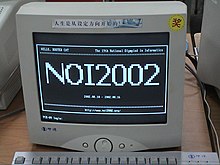






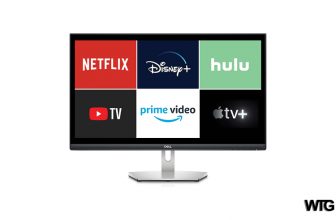
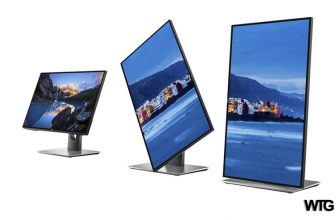
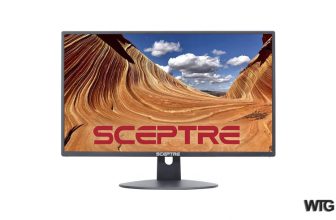

[…] Best Gaming Monitor Under $400 […]
[…] Best Gaming Monitor Under $400 […]
[…] Best Gaming Monitor Under $400 […]
[…] Best Gaming Monitor Under $400 […]
[…] Best Gaming Monitor Under $400 […]
[…] Best Gaming Monitor Under $400 […]
[…] Best Gaming Monitor Under $400 […]
[…] Best Gaming Monitor Under $400 […]
[…] Best Gaming Monitor Under $400 […]